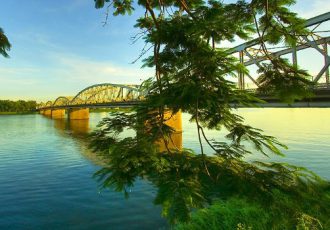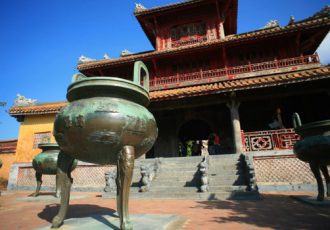The Pagoda of the Heavenly Lady (in Vietnamese: Chùa Thiên Mụ or Chùa Linh Mụ) symbolizes the Imperial City of Hue. This is not only mentioned in many romantic verses, but you can also find it described in various folkloric works, as a must-see place thanks to its sacred and mystical atmosphere.
Located on Ha Khe Hill, by the Perfume River, the Heavenly Lady Pagoda was built in 1601 by Lord NguyễnHoàng, the first Nguyễn lord of the Annam region. It is considered the oldest pagoda in Hue.
Story
Under the rule of Lord Nguyễn Phúc Chu, it was enlarged and refurbished in 1665. In 1710, this lord built Đại Hồng Chung, a large bell weighing 2 tons on which a document was engraved. In 1714, he had more than ten large-scale monuments built. For examples, the Thien Vuong temple, the Dai Hung temple, etc. Most of these no longer exist. The Lord composed a text which was engraved on a large stele. This text tells the process of the construction of the pagoda, the purchase of more than 1000 Buddhist liturgical books in China, the apology of Buddhist philosophies, the history of Thach Liem bronze.
In 1844, on the occasion of his grandmother’s birthday, Emperor Thiệu Tri built an octagonal tower.
The Octagonal Tower: The Tower of the Source of Congratulation (Phuoc Duyen)
PhuocDuyen Tower is a popular symbol related to the Heavenly Lady Pagoda. It is 21 meters long, has 7 floors. Each floor worships each Buddha. There is a spiral staircase that leads to the top floor where worship of a golden Buddha statue was practiced. In front of the tower is the pavilion of Huong Nguyen. On the roof of Huong Nguyen, a Dharma Wheel (The Dharmachakra) was added which turned when there was wind.
The storm in 1904 damaged a large part of the pagoda. Many buildings were damaged, in which the Huong Nguyen Pavilion was completely collapsed (there are now traces). In 1907, Emperor ThanhThai rebuilt, but the temple was never as big as before. Both sides of the tower have two quadrangle houses, as well as two steles of Thieu Tri. At the bottom, there are two hexagonal houses, a pavilion for the stelae and a pavilion for the bell of Lord Nguyen Phuc Chu.
Thien Mu Pagoda also has many antiquities with not only historical but also artistic values. The statue of the Guardian Geniuses, the statue of the Ten Kings of Hell, the statue of Buddha Maitreya,… or the parallel sentences, the paintings… here mark the golden age of the pagoda of the Heavenly Lady.
On the grounds of the pagoda is a large flower garden. Here, we find a hòn non bộ from Dao Tan, the ancestor of the Tuồng in Vietnam, and the car – a relic of the bronze Thich Quang Duc. Thich Quang Duc burned himself for opposing Ngo Dinh Diem’s suppression of Buddhism in 1963.
At the end of the garden is the bronze tomb of Thich Don Hau, is known for his material in the Heavenly Lady Pagoda who devoted his life to charitable activities.



